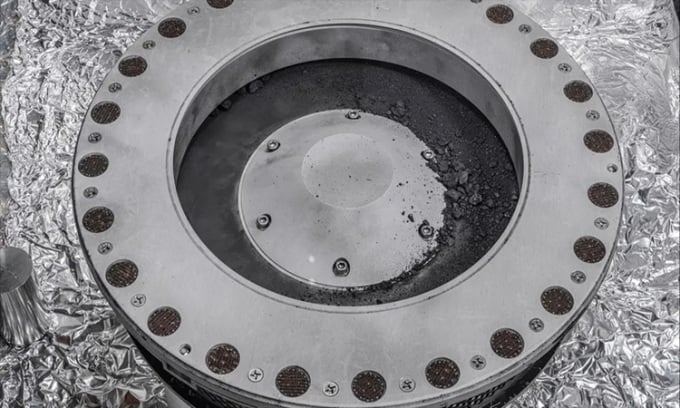NASA is having trouble opening the lid of a capsule containing a precious asteroid sample from the OSIRIS-REx mission due to two faulty locking pins.

The outside of the Bennu asteroid sample container. Photo: NASA
On September 24, the orange and white capsule containing samples collected by the OSIRIS-REx spacecraft from the asteroid Bennu landed on Earth after falling through the atmosphere at super-high speeds. Scientists on the project hoped to collect at least 60 grams of material from Bennu. On October 23, the OSIRIS-REx mission team announced that the spacecraft had done more than that. They retrieved 70.3 grams of Bennu material from the capsule, which had not yet been opened. The samples came from the area outside (and partly inside) the lid of the sample container.
According to the team, the processed sample so far includes rocks and dust found on the outside of the lid and a portion of the sample inside the lid, accessible through the lid's mylar flap. The majority of the material remains inside the Touch-and-Go Sample Acquisition Mechanism (TAGSAM) container, which is expected to be opened later to calculate the total mass of the sample.
While OSIRIS-REx wasn’t the first asteroid sample return mission, the September landing delivered the largest sample haul yet. NASA will hand over 25% of the Bennu material to more than 200 scientists at 25 different institutions, 4% to the Canadian Space Agency, and 0.5% to the Japan Aerospace Exploration Agency (JAXA). About 70% of the remaining samples will be stored at the Johnson Space Center for years to come.
Part of the reason there’s still so much Bennu left in the canister is because of a process called touch-and-go. When OSIRIS-REx’s sample collector rammed into the rock to grab some of the asteroid’s debris, scientists discovered that Bennu wasn’t as solid as expected. Instead, it was quite fragmented. So when the sample arm made contact with the rock, a cloud of dust particles rose into the air, nearly swallowing the spacecraft.
This is why scientists still don’t know exactly how much sample is in the OSIRIS-REx capsule. Next, the team will begin to open the capsule, but this can be quite difficult. After several attempts, they discovered that two of the 35 locking pins on the TAGSAM lid cannot be removed using current tools. They are developing and implementing new methods to retrieve the material inside the capsule, while ensuring the sample is safe and intact.
"While developing the procedure for accessing the final sample, the team separated TAGSAM from the nitrogen stream in a glovebox (a completely closed compartment that uses a specialized atmosphere) and stored it in a transition container, sealed with rubber gaskets and Teflon bags to ensure the specimen is kept safely in a stable nitrogen-rich environment.
An Khang (According to Live Science )
Source link



![[Photo] President of the Cuban National Assembly visits President Ho Chi Minh's Mausoleum](https://vphoto.vietnam.vn/thumb/1200x675/vietnam/resource/IMAGE/2025/10/1/39f1142310fc4dae9e3de4fcc9ac2ed0)
![[Photo] Hanoi morning of October 1: Prolonged flooding, people wade to work](https://vphoto.vietnam.vn/thumb/1200x675/vietnam/resource/IMAGE/2025/10/1/189be28938e3493fa26b2938efa2059e)
![[Photo] Keep your warehouse safe in all situations](https://vphoto.vietnam.vn/thumb/1200x675/vietnam/resource/IMAGE/2025/10/1/3eb4eceafe68497989865e7faa4e4d0e)














![[INFOGRAPHIC] DJI Osmo Nano Action camera, super compact, 4K 120fps recording](https://vphoto.vietnam.vn/thumb/402x226/vietnam/resource/IMAGE/2025/10/1/8408489112ee446dab897373255c827e)












































































Comment (0)